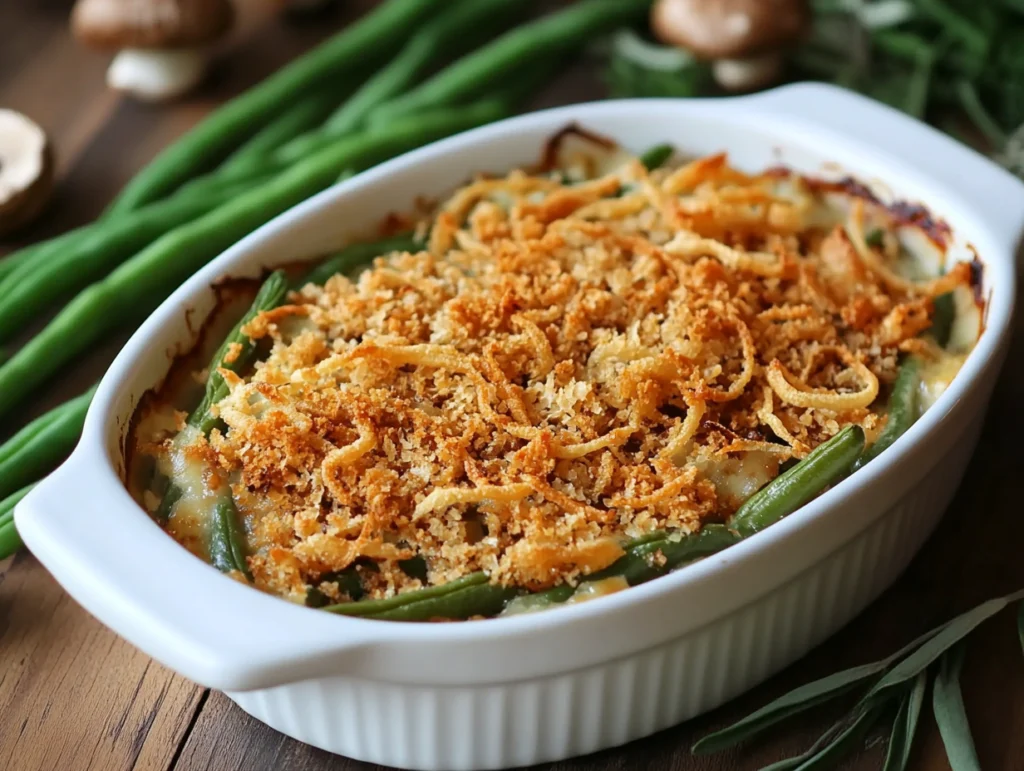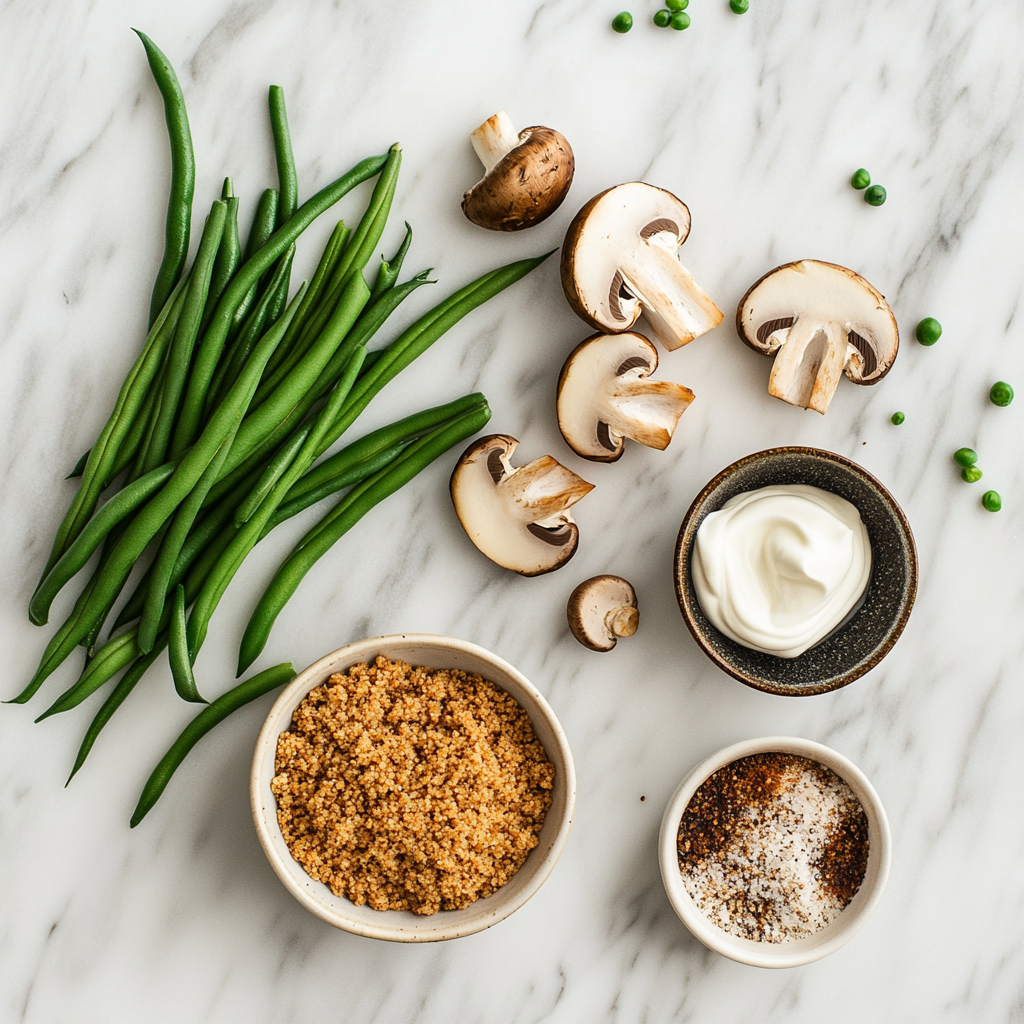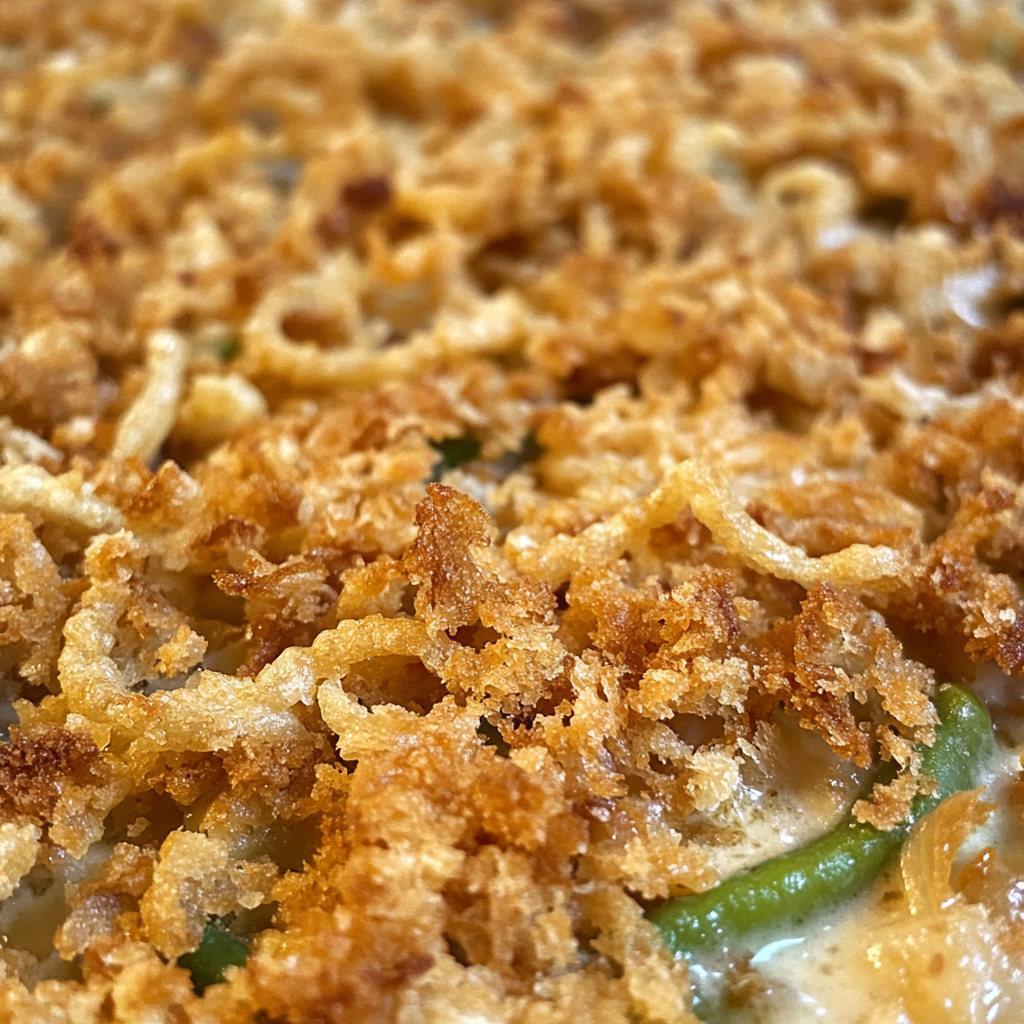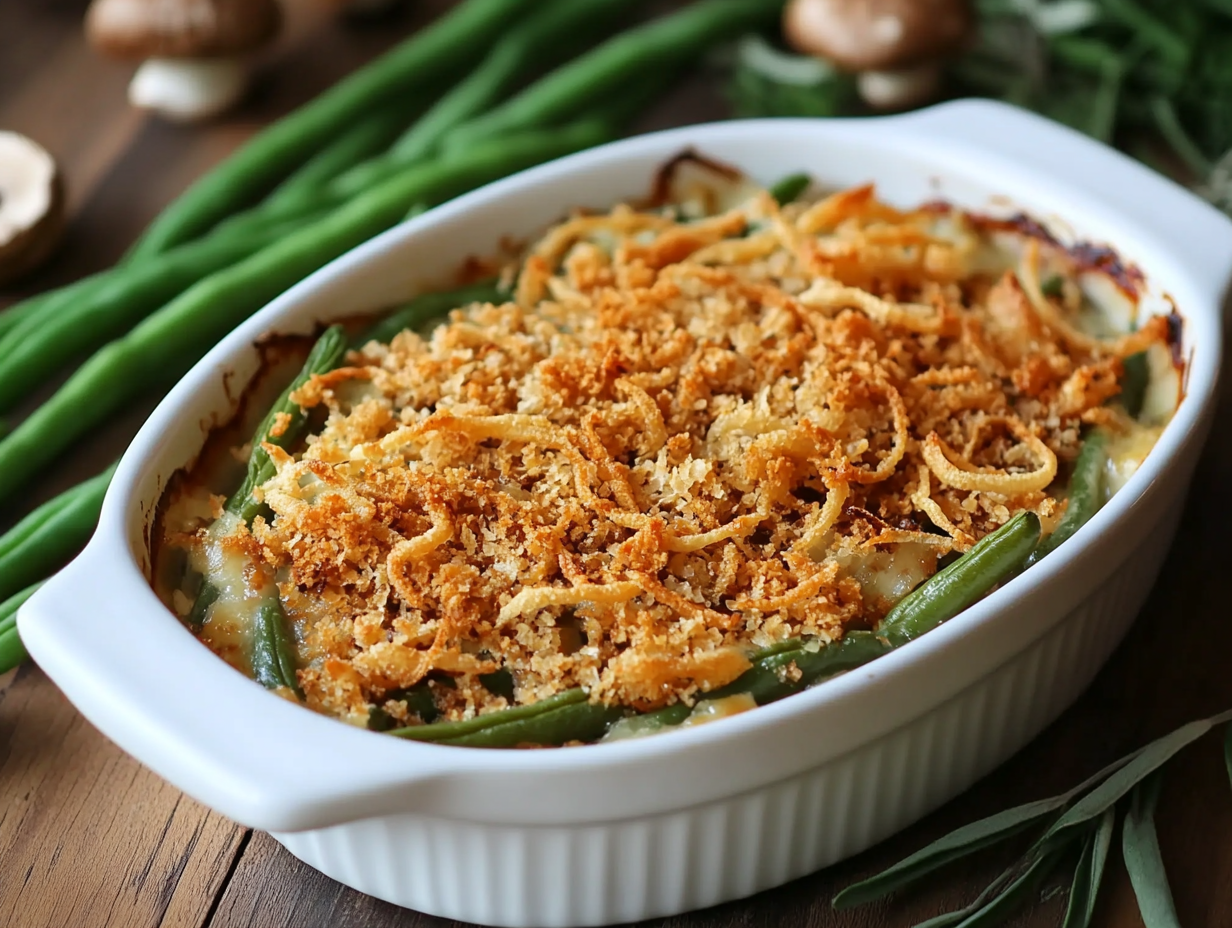
Green bean casserole is a beloved classic, especially during the holiday season, and a gluten-free green bean casserole is the perfect alternative for those with dietary restrictions. This creamy, savory dish combines tender green beans, a flavorful sauce, and crispy toppings while avoiding ingredients like wheat-based cream of mushroom soup or store-bought fried onions. Whether you have celiac disease, gluten sensitivity, or simply want to explore gluten-free cooking, this recipe ensures everyone at the table can indulge without compromise.
In this article, we’ll dive into the essentials of making a gluten-free green bean casserole, from understanding key ingredients to perfecting the recipe. Along the way, you’ll discover practical tips, creative variations, and answers to common questions about this versatile dish.
What Is Gluten-Free Cooking?
Gluten-free cooking focuses on avoiding ingredients that contain gluten, a protein found in wheat, barley, rye, and related grains. For people with celiac disease or gluten sensitivity, consuming gluten can trigger adverse health effects, making it essential to eliminate it from their diet. Fortunately, with the growing awareness of gluten-related disorders, gluten-free products and substitutes are now widely available.
Common Gluten-Free Ingredients
When adapting recipes for a gluten-free lifestyle, you’ll often rely on naturally gluten-free ingredients like fresh vegetables, meats, dairy, and legumes. Additionally, specific substitutes for gluten-containing staples include:
- Gluten-Free Flours: Rice flour, almond flour, chickpea flour, and tapioca flour.
- Thickening Agents: Cornstarch, arrowroot powder, and xanthan gum.
- Breadcrumb Alternatives: Crushed gluten-free crackers, almond meal, or gluten-free panko.
Key Considerations for Gluten-Free Recipes
Ensuring a recipe is truly gluten-free requires attention to detail. Here are some tips to keep in mind:
- Check Labels: Even seemingly safe products like canned soups or spices may contain hidden gluten. Look for a “gluten-free” certification or carefully read the ingredient list.
- Avoid Cross-Contamination: If you’re cooking in a kitchen that also handles gluten-containing foods, use separate utensils, cutting boards, and cookware.
- Test Substitutes: Not all gluten-free alternatives behave the same way as their traditional counterparts. For example, gluten-free flour blends may alter the texture of sauces or baked goods.
Why Gluten-Free Green Bean Casserole?
Traditional green bean casserole recipes often include ingredients like cream of mushroom soup thickened with wheat flour and store-bought fried onions coated in wheat-based breading. By making a gluten-free version, you can enjoy the same comforting flavors while catering to gluten-free dietary needs. This dish is perfect for family gatherings, potlucks, and holidays, offering a safe and delicious option for everyone at the table.
Ingredients for Gluten-Free Green Bean Casserole

Crafting a gluten-free green bean casserole involves replacing traditional components with gluten-free alternatives, ensuring a dish that’s both flavorful and accommodating to dietary needs. Below is a detailed list of ingredients to prepare this satisfying recipe.
- Fresh Green Beans:
- Use approximately 1 ½ pounds of fresh green beans, trimmed and cut into 1- to 2-inch pieces. Fresh beans deliver a superior texture and flavor compared to canned options.
- If fresh beans are unavailable, frozen green beans work well. Be sure to thaw and drain them thoroughly before use.
- Gluten-Free Cream of Mushroom Soup:
- Traditional cream of mushroom soups often contain wheat flour. Opt for certified gluten-free varieties available in stores, or prepare a homemade version using gluten-free flour and fresh mushrooms for complete control over flavor and texture.
- Dairy for Creaminess:
- Heavy cream or a mix of milk and cream creates a luxuriously creamy base. For a dairy-free alternative, consider unsweetened almond milk, coconut milk, or other plant-based options.
- Gluten-Free Fried Onions:
- Replace conventional fried onions with gluten-free options from specialty retailers. Alternatively, make your own by coating thinly sliced onions with gluten-free flour and frying until golden and crisp.
Seasonings and Flavor Enhancers
- Garlic Powder and Onion Powder:
- These pantry staples are essential for building a rich and savory base. Use about 1 teaspoon of each.
- Salt and Black Pepper:
- Adjust the seasoning to taste. Generally, ½ teaspoon of salt and a pinch of pepper provide a balanced flavor.
- Tamari or Gluten-Free Soy Sauce:
- Add about 1 tablespoon of tamari to enhance the dish with a subtle umami note. It’s an excellent gluten-free alternative to regular soy sauce.
- Nutmeg (Optional):
- A small pinch of nutmeg can elevate the creaminess of the sauce, adding a hint of warmth.
Optional Ingredients for Added Flavor
- Cheese:
- For a cheesy variation, mix shredded Parmesan or sharp cheddar into the sauce or sprinkle it on top before baking.
- Gluten-Free Breadcrumbs or Crushed Crackers:
- For an extra crunch, consider topping the casserole with gluten-free panko crumbs or crushed gluten-free crackers.
- Bacon Bits:
- Crumbled cooked bacon adds a smoky, savory dimension that complements the creamy sauce.
Shopping Tips for Gluten-Free Ingredients
- Certified Gluten-Free Products:
- Look for the “gluten-free” certification label to avoid cross-contamination and ensure ingredients meet gluten-free standards.
- Read Product Labels Carefully:
- Be vigilant about hidden gluten in processed foods like soups, sauces, and spice blends. Ingredients like malt, modified food starch, or regular soy sauce can contain gluten.
- Explore Specialty Stores:
- Visit health food stores or browse online retailers for hard-to-find items like gluten-free fried onions and flour blends.
Step-by-Step Recipe
Step-by-Step Recipe for Gluten-Free Green Bean Casserole
Creating a gluten-free green bean casserole is straightforward and rewarding. Follow these step-by-step instructions to make a dish that’s sure to impress.
Preparation
- Preheat the Oven:
- Set your oven to 375°F (190°C) to ensure it’s ready for baking once the casserole is assembled.
- Prepare the Green Beans:
- If using fresh green beans, wash them thoroughly, trim the ends, and cut them into 1- to 2-inch pieces.
- Blanch the green beans by boiling them in salted water for 3-5 minutes until they’re tender-crisp. Drain them and immediately plunge them into a bowl of ice water to preserve their bright green color and stop the cooking process.
- If using frozen green beans, thaw them completely and pat them dry.
- Make the Gluten-Free Fried Onions (Optional):
- Thinly slice a large onion and toss the slices in gluten-free flour.
- Heat oil in a skillet over medium heat, then fry the onions until golden brown and crispy. Drain on paper towels and set aside.
Cooking the Creamy Sauce
- Sauté the Mushrooms (if using fresh ones):
- Heat 2 tablespoons of butter or olive oil in a large skillet. Add 1 cup of sliced mushrooms and cook until they release their moisture and become tender.
- Create the Roux:
- To the skillet with mushrooms, add 2 tablespoons of gluten-free all-purpose flour or cornstarch. Cook for 1-2 minutes to remove the raw flour taste.
- Add Liquids:
- Slowly pour in 1 ½ cups of milk or cream, whisking constantly to avoid lumps. Stir until the mixture thickens into a creamy sauce.
- Season the Sauce:
- Add 1 tablespoon of tamari (or gluten-free soy sauce), 1 teaspoon each of garlic and onion powder, a pinch of nutmeg (optional), salt, and pepper to taste. Adjust seasonings as needed.
Assembling the Casserole
- Combine the Ingredients:
- In a large mixing bowl, combine the blanched green beans with the creamy sauce, ensuring the beans are evenly coated.
- Prepare the Casserole Dish:
- Lightly grease a 9×13-inch casserole dish with butter or oil. Transfer the green bean mixture into the dish, spreading it evenly.
- Add the Toppings:
- Sprinkle gluten-free fried onions, breadcrumbs, or a mixture of shredded cheese and breadcrumbs over the top for a flavorful and crispy layer.
Baking the Casserole
- Bake:
- Place the casserole in the preheated oven and bake for 25-30 minutes, or until the top is golden brown and the sauce is bubbling around the edges.
- Rest Before Serving:
- Allow the casserole to rest for 5-10 minutes after removing it from the oven. This helps the dish set and makes it easier to serve.
Tips for Success
- Check the Consistency of the Sauce: If it seems too thick, add a splash of milk or broth. If it’s too thin, cook it a little longer to reduce.
- Don’t Skip Blanching the Green Beans: This step ensures they’re perfectly cooked and vibrant in the final dish.
- Customize Toppings: Experiment with different gluten-free toppings, like crushed nuts or grated Parmesan, for added texture and flavor.
Common Mistakes to Avoid When Making Gluten-Free Green Bean Casserole
Common Mistakes to Avoid
Crafting a gluten-free green bean casserole can be straightforward, but certain missteps can impact its texture, flavor, or overall success. Here’s a list of common mistakes and tips to avoid them.
Mistakes During Ingredient Selection
- Using Non-Gluten-Free Products:
- Mistake: Accidentally using products like regular soy sauce, cream of mushroom soup, or breadcrumbs that contain gluten.
- Solution: Always check labels for “gluten-free” certification and read the ingredient list carefully.
- Relying on Canned Green Beans:
- Mistake: Using canned green beans can lead to a mushy casserole with an overly soft texture.
- Solution: Opt for fresh or frozen green beans, which maintain their firmness and vibrant color.
Mistakes in Preparation
- Skipping the Blanching Step:
- Mistake: Directly using raw green beans without blanching can result in unevenly cooked beans or a crunchy texture.
- Solution: Always blanch fresh green beans in salted boiling water and shock them in ice water to lock in color and tenderness.
- Making a Thin Sauce:
- Mistake: A watery or runny sauce doesn’t cling well to the green beans, leaving the dish less cohesive.
- Solution: Ensure the sauce is thickened adequately on the stovetop by cooking it longer or adding more gluten-free flour or cornstarch.
- Adding Toppings Too Early:
- Mistake: Adding fried onions, breadcrumbs, or other toppings too soon can cause them to burn during baking.
- Solution: Add toppings in the final 10-15 minutes of baking for optimal crispness without overbrowning.
Baking Errors
- Overbaking the Casserole:
- Mistake: Baking the dish for too long can dry out the sauce and make the green beans soggy.
- Solution: Bake the casserole just until the sauce bubbles and the topping turns golden brown (usually 25-30 minutes).
- Using the Wrong Baking Dish:
- Mistake: Using a dish that’s too large or too small can affect how the casserole cooks, leading to uneven heating.
- Solution: Use a 9×13-inch baking dish for even cooking and proper layering.
Flavors and Seasonings
- Underseasoning the Dish:
- Mistake: A bland casserole can lack depth, especially if the green beans and sauce are not seasoned properly.
- Solution: Taste the sauce before mixing it with the green beans, adjusting salt, pepper, and seasonings like garlic powder or tamari as needed.
- Overpowering the Flavors:
- Mistake: Overusing ingredients like tamari, nutmeg, or bacon can overwhelm the dish.
- Solution: Use strong flavors sparingly and balance them with the natural taste of green beans.
Handling Gluten-Free Challenges
- Neglecting Cross-Contamination:
- Mistake: Using utensils, cookware, or surfaces that have come into contact with gluten can lead to cross-contamination.
- Solution: Always use separate tools and thoroughly clean surfaces when cooking for gluten-sensitive individuals.
- Overlooking Texture in Gluten-Free Substitutes:
- Mistake: Some gluten-free alternatives, like breadcrumbs or fried onions, can turn soggy or clump if not prepared correctly.
- Solution: Lightly toast breadcrumbs before using them, and fry onions just before adding them for the best results.
Storage and Reheating Mistakes
- Improper Storage:
- Mistake: Storing leftovers in non-airtight containers can dry out the casserole or cause it to absorb fridge odors.
- Solution: Use airtight containers to keep leftovers fresh, and consume within 3 days.
- Reheating the Casserole Incorrectly:
- Mistake: Microwaving leftovers can make the sauce watery and the topping soggy.
- Solution: Reheat in an oven at 350°F (175°C) until warmed through to preserve texture and flavor.
How to Store and Reheat Gluten-Free Green Bean Casserole
Storing Leftovers
Let the casserole cool completely before storing. Place it in an airtight container and refrigerate for up to 3 days. For longer storage, freeze it for up to 1 month. If freezing, assemble the casserole without the topping and add it fresh when reheating.
Reheating Instructions
To reheat, preheat the oven to 350°F (175°C). Cover the casserole with foil and bake for 20-30 minutes or until warmed through. Remove the foil in the last 5 minutes to crisp the topping. For individual portions, microwave on medium for 2-3 minutes, or reheat in a skillet on low heat with a splash of milk to refresh the sauce.
Tips for Best Results
- Store toppings separately when freezing to maintain crunch.
- Avoid overheating to preserve the casserole’s texture.
- Reheat in the oven for the best flavor and crispiness.
Frequently Asked Questions (FAQs) About Gluten-Free Green Bean Casserole
Can I Make Gluten-Free Green Bean Casserole Ahead?
Yes, assemble it without the topping and refrigerate for 24 hours or freeze for up to 1 month. Add the topping just before baking.
What’s a Good Substitute for Fried Onions?
Use store-bought gluten-free fried onions, homemade fried onions with gluten-free flour, or alternatives like crushed potato chips or breadcrumbs.
Can I Make It Dairy-Free?
Yes, replace dairy with almond, coconut, or cashew milk and use a dairy-free cream of mushroom soup.
How Do I Prevent It From Getting Watery?
Blanch and dry the green beans thoroughly, thicken the sauce properly, and avoid tightly covering the dish during baking.
How Do I Keep the Topping Crispy?
Add the topping in the last 10-15 minutes of baking, toast breadcrumbs beforehand, or store the topping separately if preparing ahead.

One of the most common questions when adapting this dish is, What can I substitute for French fried onions in green bean casserole? Luckily, there are plenty of delicious options, including gluten-free fried onions, toasted breadcrumbs, or crushed potato chips. If you’re wondering, Can green beans be gluten free?, the good news is that they’re naturally gluten-free, making them a perfect base for this recipe.
To avoid issues like mushy beans, it’s important to understand cooking techniques. If you’ve ever asked, Why is my green bean casserole mushy?, the answer often lies in overcooking or skipping the blanching process. Following these simple tips will help you achieve a perfectly textured casserole every time.
Green bean casserole is a cherished dish that graces many holiday tables. With a little care, it’s easy to make this classic gluten-free while maintaining its creamy, crunchy, and comforting appeal. Whether you’re new to gluten-free cooking or simply looking for a versatile recipe, this dish offers everything you need for a satisfying meal.

